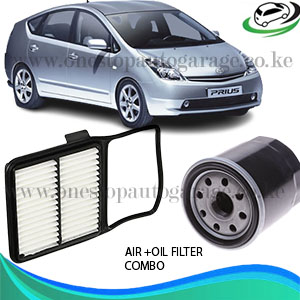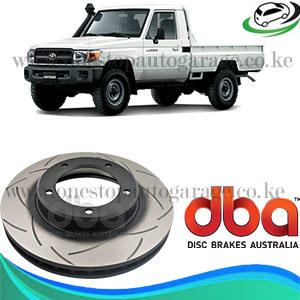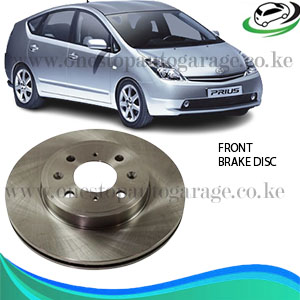-8%
Get Front Brake Disc Toyota Prius NHW20
Brake discs, also known as brake rotors, are essential components of a vehicle’s braking system. They play a critical role in slowing down or stopping the vehicle by converting kinetic energy into heat energy through friction. Here’s a detailed look into the function, types, construction, and signs of issues with brake discs:
Function of Brake Discs:
-
1. Kinetic Energy Conversion:
- Frictional Force: When the brake pedal is depressed, hydraulic pressure forces brake pads against the spinning brake discs mounted on each wheel.
- Transformation of Energy: The resulting friction between the brake pads and discs converts the kinetic energy of the rotating wheels into heat energy.
2. Heat Dissipation:
- Heat Management: Brake discs are designed to absorb and dissipate the intense heat generated during braking.
- Vented Design: Many brake discs feature a vented design with internal vanes or fins. These channels increase surface area and facilitate airflow, enhancing heat dissipation and reducing the risk of brake fade—a condition where brakes lose effectiveness due to overheating.
3. Material Composition:
- Cast Iron: Most brake discs are made from cast iron due to its excellent heat absorption and dissipation properties. It’s also relatively cost-effective and durable.
- Carbon-Ceramic: High-performance vehicles may use carbon-ceramic composite discs, which offer superior heat resistance and lighter weight. They are less prone to warping under extreme conditions but come at a higher cost.
4. Structural Integrity:
- Hub and Rotor Assembly: Brake discs are circular plates with a central hub that connects to the wheel hub assembly.
- Mounting: They must be securely mounted to ensure they rotate concentrically with the wheel hub, minimizing vibration and ensuring effective braking.
5. Brake Force Distribution:
- Uniform Friction Surface: The smooth, flat friction surface of the brake discs provides a consistent contact area for the brake pads.
- Efficient Braking: This uniform contact allows for even distribution of braking force, ensuring predictable and reliable deceleration of the vehicle.
6. Role in Vehicle Safety:
- Emergency Braking: Brake discs play a crucial role in emergency braking situations, where rapid deceleration is required to avoid collisions or hazards.
- Stability and Control: They contribute to the vehicle’s stability by enabling smooth transitions from acceleration to braking, maintaining control over the vehicle’s directional stability.
7. Maintenance and Performance:
- Wear and Replacement: Over time, brake discs wear down due to friction and heat. Regular inspection and measurement of disc thickness are essential to determine when replacement is necessary.
- Pad Compatibility: Proper functioning of brake discs also depends on compatible brake pads that provide adequate friction without causing excessive wear or damage to the discs.
Types of Brake Discs:
- Solid Brake Discs:
- Found in many standard passenger vehicles, solid brake discs are simple in design and provide adequate braking performance for everyday driving conditions.
- Vented Brake Discs:
- Commonly used in performance vehicles and heavier vehicles, vented brake discs have vanes or fins between two friction surfaces.
- These vanes allow for better heat dissipation and help reduce the risk of brake fade during prolonged or heavy braking.
- Drilled Brake Discs:
- Drilled brake discs have holes drilled through them, which can aid in heat dissipation and water evacuation in wet conditions.
- They are often used in sports cars and racing applications, although they may be prone to cracking under severe stress.
- Slotted Brake Discs:
- Slotted brake discs have shallow slots machined into the friction surface.
- These slots help to deglaze the brake pads and prevent brake fade by maintaining a clean contact surface between the pads and discs.
Construction of Brake Discs:
- Material: Brake discs are typically made from cast iron or, in some high-performance applications, carbon-ceramic composites.
- Design: They have a flat, circular shape with a hub at the center for mounting onto the wheel hub assembly.
- Ventilation: Vented discs have internal vanes or fins that create channels for air circulation, enhancing heat dissipation.
Signs of Issues with Brake Discs:
-
1. Brake Noise:
- Squealing or Squeaking: High-pitched noises when applying the brakes can indicate worn brake pads or uneven wear on the brake discs.
- Grinding or Scraping: Metallic grinding sounds suggest that the brake pads are worn down to the metal backing plates or that debris is trapped between the pads and the discs.
2. Vibrations or Pulsations:
- Brake Pedal Vibration: A pulsating sensation through the brake pedal or steering wheel during braking indicates warped brake discs.
- Causes: Warping can occur due to overheating from aggressive braking, prolonged braking on steep descents, or improper installation.
3. Reduced Braking Performance:
- Increased Stopping Distance: If the vehicle takes longer to come to a stop, it may indicate worn brake pads or discs.
- Inadequate Friction: Insufficient friction between the brake pads and discs can occur due to glazed or contaminated brake surfaces.
4. Visible Signs of Wear or Damage:
- Grooves or Scoring: Deep grooves or scoring marks on the surface of the brake discs indicate uneven wear or damage.
- Rust or Corrosion: Surface rust on the brake discs, especially in areas where the pads do not contact, can affect braking performance.
5. Overheating and Discoloration:
- Blue or Purple Coloration: Excessive heat can cause the brake discs to change color, indicating overheating.
- Caution: Severe overheating can lead to thermal cracking or deformation of the discs, compromising their structural integrity.
6. Brake Fluid Leaks:
- Fluid Contamination: Brake fluid leaks onto the brake discs can reduce friction and cause erratic braking.
- Inspect for Leaks: Check for signs of brake fluid leaks around the calipers, hoses, or master cylinder.
7. Pulling or Uneven Braking:
- Vehicle Pulling: If the vehicle pulls to one side during braking, it may indicate uneven brake pad wear or a stuck caliper piston.
- Uneven Pad Contact: Uneven contact between the brake pads and discs can cause uneven braking forces.
8. Excessive Brake Dust:
- Abnormal Brake Dust: While some brake dust is normal, excessive brake dust on the wheels may indicate excessive wear or sticking brake components.
9. Inspection and Diagnosis:
- Professional Inspection: If you notice any of these signs, have a qualified mechanic inspect the brake discs and entire braking system.
- Measurement of Disc Thickness: Measure the thickness of the brake discs to ensure they are within the manufacturer’s recommended specifications.
- Replacement as Needed: Replace brake discs that are worn beyond specifications, warped, cracked, or showing other signs of damage to restore safe braking performance.
Maintenance and Replacement:
- Regular Inspection: Check brake discs during routine maintenance or whenever performing brake pad replacements.
- Measure Thickness: Monitor the thickness of the brake discs to ensure they are within the manufacturer’s recommended minimum thickness.
- Replace as Needed: Replace brake discs if they are worn beyond specifications, warped, cracked, or otherwise damaged to ensure safe braking performance.
Follow us on Facebook For more parts.



